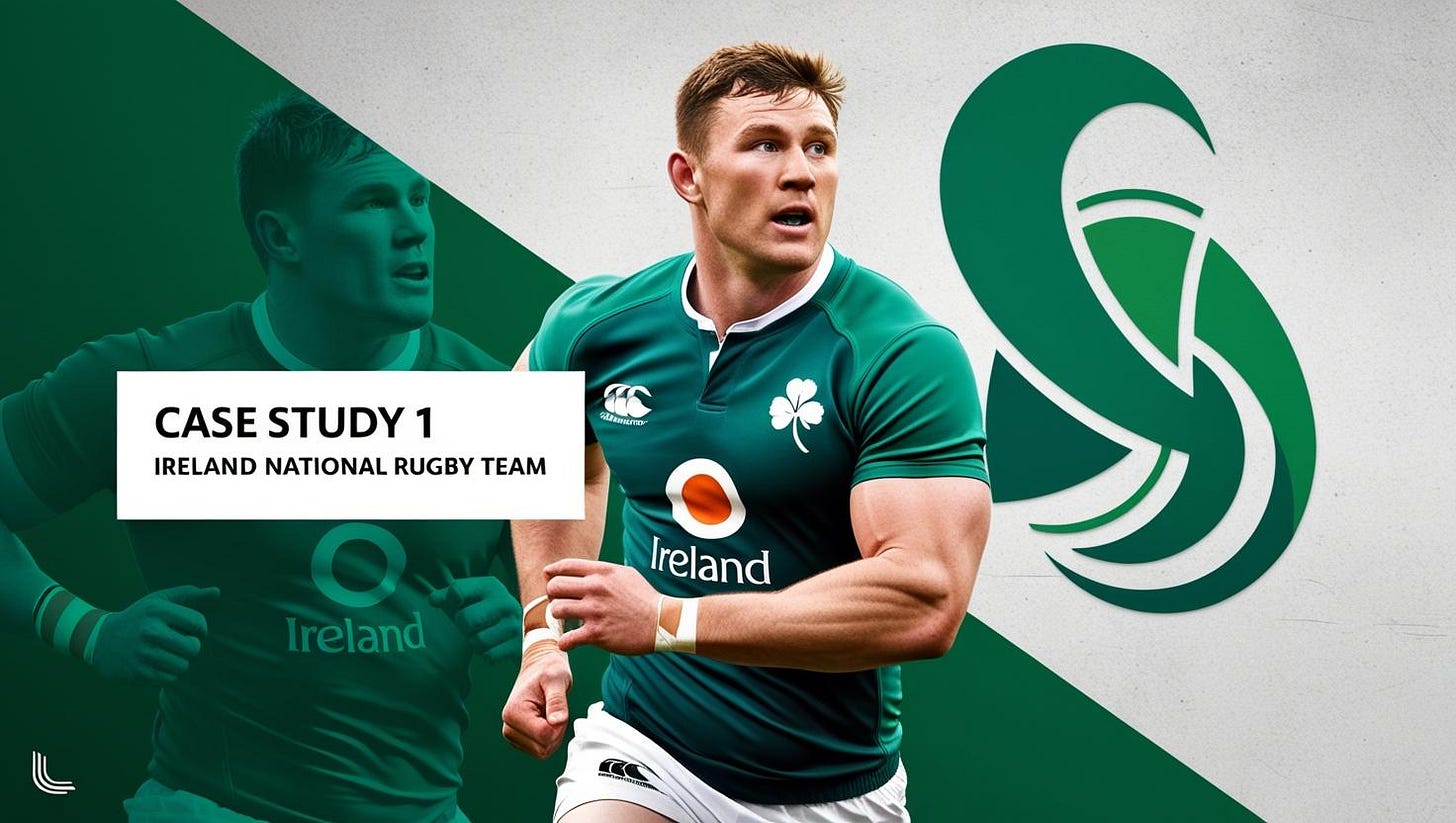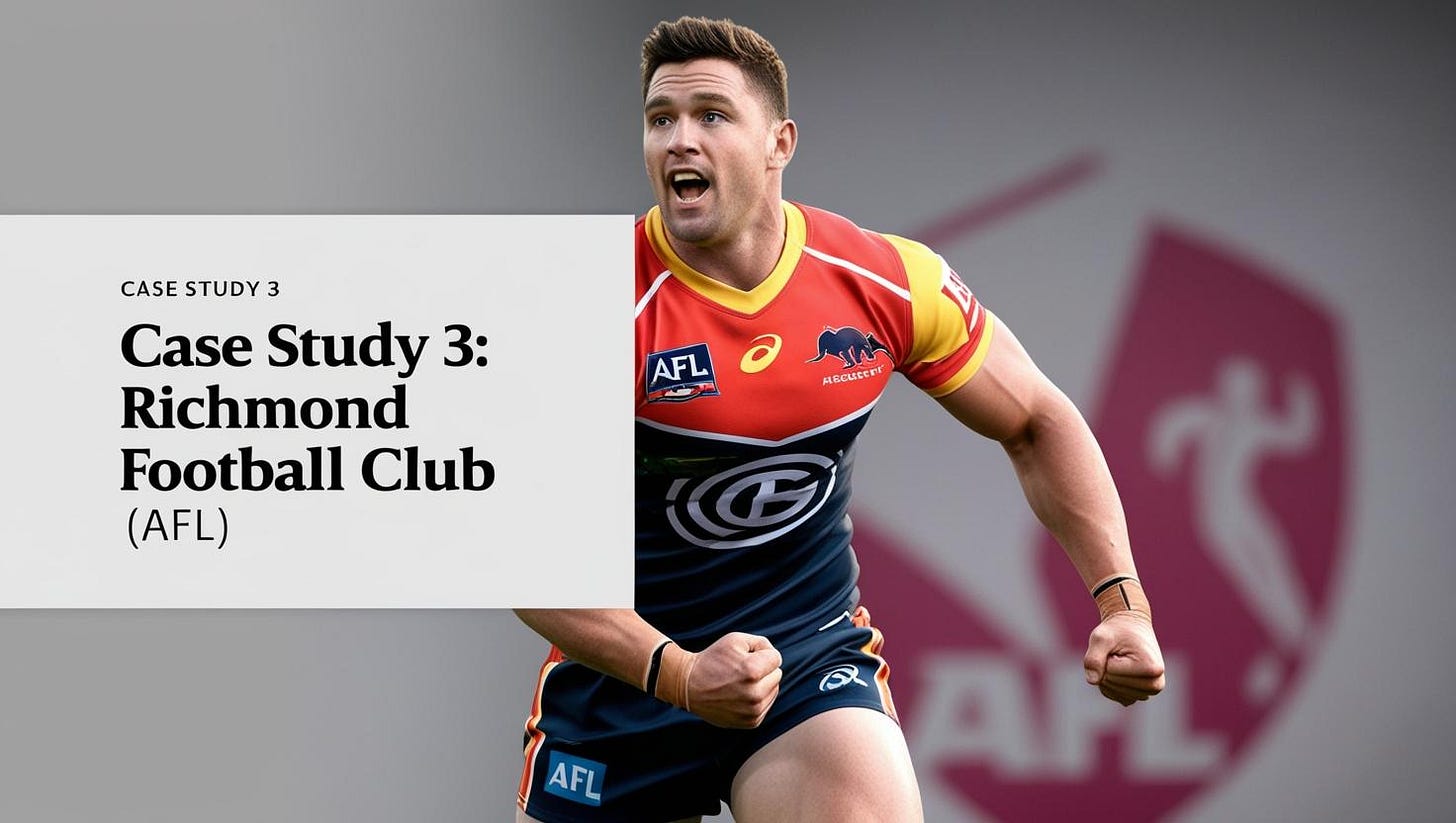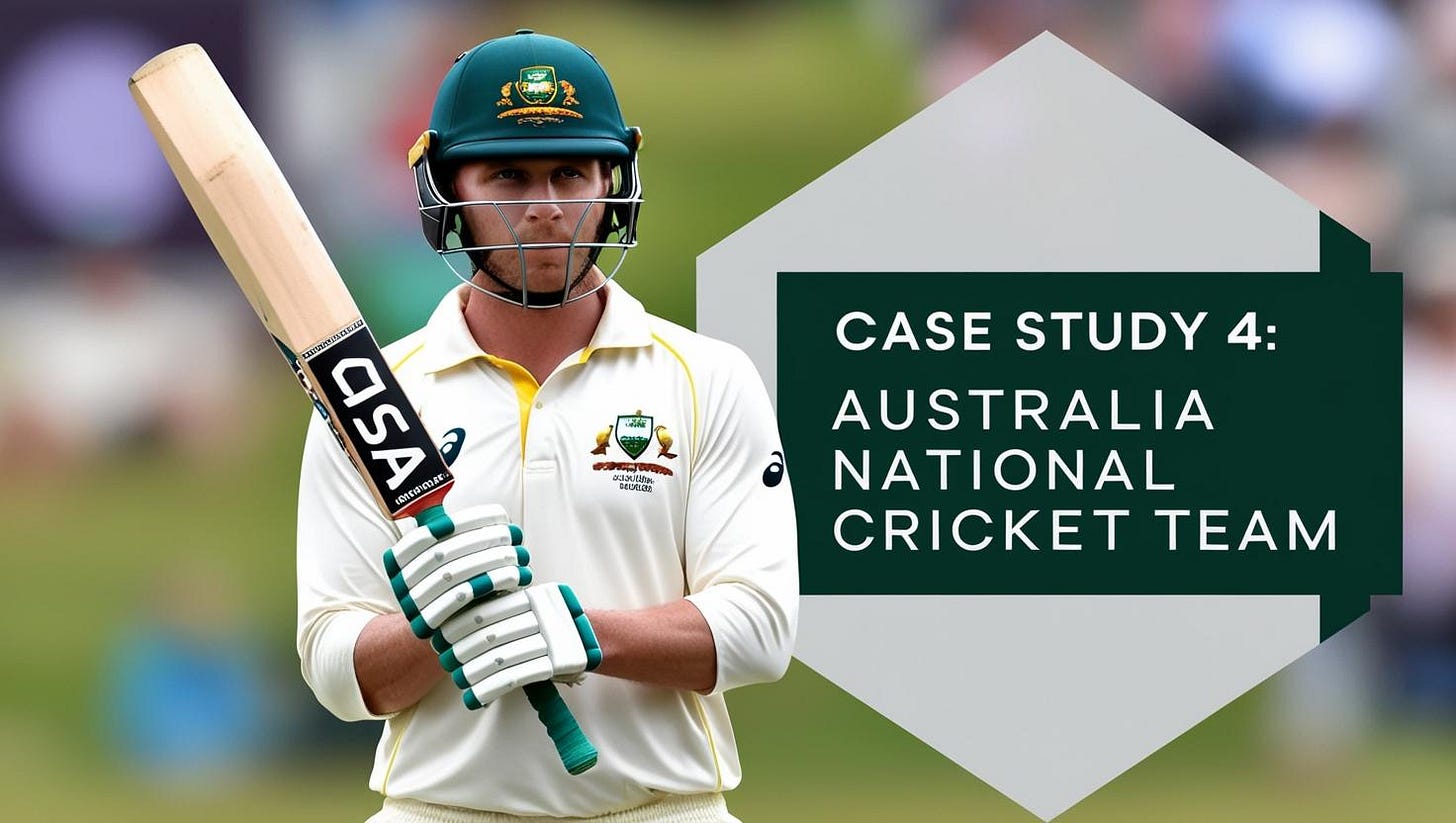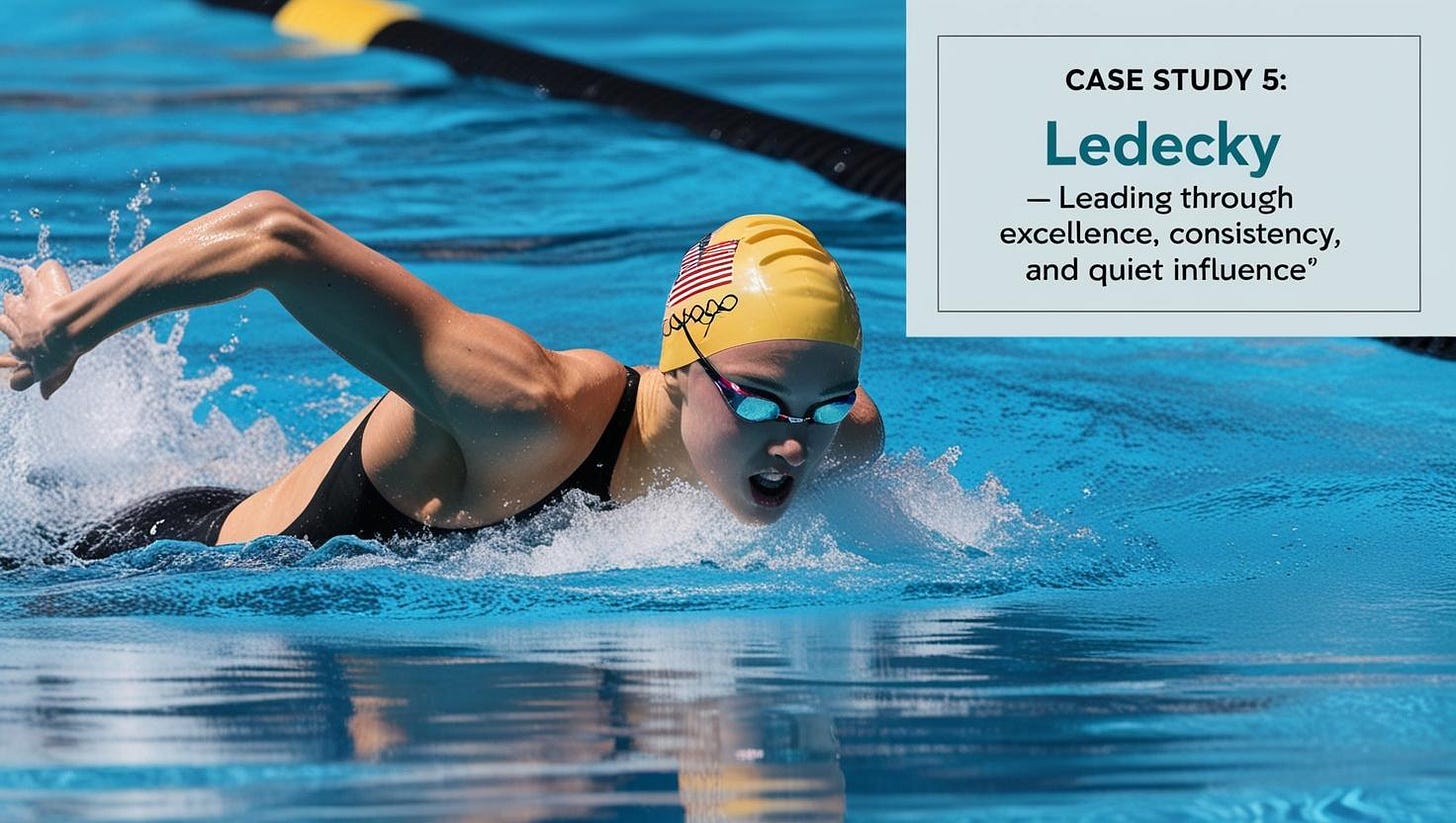📚 Upside Analysis: Leadership Skills Development - 5 Case Studies: (1) Ireland Rugby, (2) England Rugby, (3) Australia National Cricket Team, (4) Richmond Football Club (AFL), (5) Katie Ledecky.
Case Study 1: Ireland National Rugby Team
Ireland’s national rugby team has undergone a profound cultural and performance transformation over the past decade. Known for resilience and tactical excellence, their recent rise—capped by a Six Nations Grand Slam and a world No. 1 ranking—has been equally underpinned by their leadership development. The IRFU’s leadership approach has moved from hierarchical command to a player-driven, values-aligned model.
Methodology
Leaders at Every Level: Former head coach Andy Farrell implemented a distributed leadership structure where players from different positions and seniorities were empowered to lead in training and matches. Leadership responsibilities were integrated into everyday operations.
Off-Field Character Building: Players engaged in community outreach, storytelling sessions, and personal development workshops. By cultivating leadership beyond rugby, the IRFU fostered greater emotional intelligence, humility, and perspective.
Scenario-Based Learning: Leadership groups underwent military-inspired situational training, such as decision-making under fatigue and ambiguity. Workshops covered topics from ethics to performance psychology.
Integrated Coaching Alignment: Coaches were trained to model servant leadership. Tactical decision-making was increasingly delegated to players during matches, reinforcing autonomy and trust.
Results
Sustained Excellence: Ireland won the Six Nations Grand Slam in 2023 and entered the 2023 Rugby World Cup ranked No. 1 globally. Despite a quarterfinal exit, their composure and strategic discipline drew widespread praise.
Depth in Leadership: A broader group of leaders emerged, including veterans and new caps, ensuring continuity and adaptability.
Cultural Cohesion: Players cited a deeper connection with teammates and staff, and greater buy-in during high-pressure moments.
Lessons Learned / Conclusion
Ireland’s case underscores that elite rugby success is no longer just about tactics or fitness—it’s about leadership depth and shared values. By investing in holistic player growth, they’ve built a team culture defined by accountability, adaptability, and unity.
Case Study 2: England Rugby
Following the 2019 Rugby World Cup, England Rugby embarked on a systemic leadership overhaul. The RFU aimed to deepen leadership capacity across all levels—from grassroots programs to the elite national team—focusing on resilience, strategic thinking, and accountability.
Methodology
Rotating Leadership Councils: A structure allowing players to share responsibility for standards, culture, and communication, fostering shared ownership.
Cross-Domain Partnerships: Collaborated with the UK Special Forces and RAF Red Arrows to train players in calm decision-making, composure under pressure, and leadership in high-stakes environments.
Future Leaders Program: A long-term initiative to identify and develop young players with leadership potential. Includes mentoring, scenario-based learning, and off-field education.
Behavioral and Data-Driven Insights: Used psychometric testing and performance analytics to profile leadership traits and align roles with individual strengths.
Results
Stronger Tournament Performance: Reached the 2023 Rugby World Cup semi-finals, displaying improved composure and strategic clarity.
Cultural Accountability: Players now take greater ownership of team culture and internal standards.
Leadership Depth: Multiple players are prepared to step into leadership roles, offering adaptability during tours and major competitions.
Lessons Learned / Conclusion
England Rugby demonstrates how long-term investment in leadership development, supported by data and cross-sector learning, can stabilize performance and build resilience. Their approach offers a model for embedding leadership at every stage of athlete development.
Case Study 3: Richmond Football Club (AFL)
Introduction
Richmond Football Club’s cultural and performance renaissance from 2017 onward has been widely studied across elite sports. Prior to this transformation, Richmond had endured decades of underachievement, despite being one of the oldest and most supported clubs in the AFL. A key driver in its turnaround was an intentional and deeply human-centered leadership development initiative that reframed success not just as winning premierships but as cultivating holistic, self-aware, and resilient leaders at every level of the organization.
Methodology
Player-Led Leadership Model: Richmond abolished rigid hierarchies in favor of a rotational, player-driven leadership structure. Senior players were elected by peers and held accountable for maintaining values rather than only performance stats. This model empowered athletes to contribute to the team’s culture and identity.
Emotional Intelligence and Vulnerability Training: Collaborated with performance psychologists and leadership consultants to run workshops centered on self-awareness, emotional literacy, and empathetic communication. These sessions enabled players to understand themselves and their teammates beyond performance roles.
The 'Tell Your Story' Initiative: One of the most radical methods involved players publicly sharing personal life stories in team meetings to foster vulnerability-based trust. This created stronger emotional bonds and helped dismantle stereotypes, prejudices, and performance-only identities.
Cultural Ethos: Connection Over Compliance: Leadership training and development were grounded in a values-first approach. Trust, honesty, care, and vulnerability were institutionalized across coaching, player development, and executive leadership. Coaches and staff were encouraged to model these values consistently.
Results
On-field Success: Richmond won three AFL premierships (2017, 2019, 2020), breaking a 37-year drought and maintaining a high-performance standard over multiple seasons. The team consistently demonstrated mental toughness and unity.
Retention and Cohesion: The emotional trust and empowerment embedded in leadership development led to unusually high levels of player retention, reduced off-field issues, and increased locker room cohesion. Players cited deeper personal connections as a major motivator to stay and perform.
Cultural Replication: Richmond’s model has influenced other AFL teams and organizations internationally. It has become a case study for corporate leadership programs and sports organizations looking to transform team dynamics and morale.
Lessons Learned / Conclusion
Richmond's success shows the power of emotionally intelligent leadership that prioritizes trust and authenticity over rigid hierarchy. By empowering players to lead through vulnerability and connection, the club redefined what elite leadership looks like in team sport. The long-term sustainability of this model proves that cultural transformation can be a competitive advantage when done authentically.
Case Study 4: Australia National Cricket Team
In the aftermath of the 2018 ball-tampering scandal, Australian cricket undertook a significant overhaul in leadership development. The incident revealed systemic issues in values alignment and ethical decision-making, sparking a cultural and leadership reset centered on humility, accountability, and long-term trust-building. What followed was not just a reputational repair but a full-scale organizational reinvention.
Methodology
Ethical Leadership Charter: Players co-developed a leadership pact that committed the team to values of respect, fairness, and sportsmanship. This document was revisited annually and used to guide decisions.
Psychological Resilience Training: Partnered with mental skills coaches to build tools for stress management, emotional regulation, and focus under scrutiny. Sessions covered mindfulness, cognitive behavioral strategies, and composure in crisis.
Multi-Format Leadership Consistency: A coordinated leadership group was maintained across Test, ODI, and T20 teams to ensure cohesion and philosophical alignment. Leaders met regularly to align tactics and values.
Transparent Communication Structures: Press conferences, team documents, and leadership meetings emphasized open, honest, and reflective communication. Players were trained in media interaction and public accountability.
Results
Return to Success: Retained the Ashes (2019), won the ICC World Test Championship (2023), and rebuilt international credibility. Performance was no longer just strong—it was resilient and values-aligned.
Restored Public Trust: Public and fan perception improved significantly, with the team seen as more grounded and respectful. Sponsorships that had been jeopardized returned, and new commercial opportunities emerged.
Emergent Ethical Leaders: Players like Pat Cummins and Marnus Labuschagne have emerged as ambassadors for a new era of values-driven leadership. Their example has influenced junior cricket and inspired a broader national conversation.
Lessons Learned / Conclusion
Australia’s experience shows how a crisis can catalyze profound leadership reform. By prioritizing ethics, transparency, and resilience, they not only regained competitiveness but restored their national reputation. Their story is a template for high-stakes organizational redemption driven by courageous leadership change.
Case Study 5: Katie Ledecky — Leading Through Excellence, Consistency, and Quiet Influence
Katie Ledecky is a 7-time Olympic gold medalist and 21-time World Champion in freestyle swimming, specializing in middle- and long-distance events. She emerged on the global stage at the age of 15 during the 2012 London Olympics, winning gold in the 800m freestyle. Since then, she has redefined excellence in distance swimming and evolved from a prodigy into a respected leader in the global swimming community.
Though swimming is an individual sport, Ledecky’s leadership journey shows how influence, character, and consistency can make an athlete a guiding force—even without formal titles.
Leadership Evolution
1. Stage 1: Leading by Example (2012–2016)
At the start of her international career, Ledecky wasn’t outspoken or directive. Her leadership came through relentless preparation, humility, and record-breaking performances. She didn’t command with words, but with actions—setting standards for effort, discipline, and mindset.
Leadership Traits:
Discipline and routine
Focused presence in training environments
Quiet but powerful influence on team culture
2. Stage 2: Transition to Purposeful Leadership (2016–2021)
Following her 4-gold medal haul at the 2016 Rio Olympics, Ledecky recognized her growing role as a leader on Team USA. She began to speak more openly in team meetings, share insights with younger swimmers, and take on mentoring roles during training camps.
Her decision to move from Stanford to the University of Florida in 2021 was driven by a desire to stay in a highly competitive training environment—and help build a culture that sustained both elite performance and athlete development.
Key Leadership Actions:
Shared strategies for race visualization and pacing with young teammates
Regularly reached out to junior swimmers before major competitions
Spoke up in leadership meetings about athlete welfare and preparation cycles
3. Tokyo 2020 Olympics (Held in 2021): Leadership in Adversity
Tokyo tested Ledecky’s leadership in new ways. She lost the 400m freestyle to Ariarne Titmus of Australia—a rare defeat. But instead of retreating, she responded with emotional resilience, winning the 800m and 1500m freestyle in dominant fashion.
In interviews, she praised her competitors, took accountability, and reframed setbacks as fuel for growth.
“Each day I work on getting better, and even the bad days have something good that comes out of them,” Ledecky told Forbes. “One thing my coaches say is that I fail spectacularly in practice — and that’s something that I actually work toward.
She also talked about the importance of setting up goals for ourselves to achieve the impossible:
“Set goals that, when you set them, you think they're impossible. But then every day you can work towards them, and anything is possible so keep working hard and follow your dreams”
Leadership Displayed:
Emotional maturity in public-facing adversity
Role modeling resilience for younger athletes
Publicly shifting the narrative around success and pressure
4. Beyond Competition: Leadership Through Advocacy and Mentorship
Today, Ledecky is not only a role model in the pool but also a champion for education, equity in sports, and youth development. She serves as an ambassador for STEM education through her partnership with Panasonic and speaks to high school athletes about balancing academics and athletics.
She has mentored rising stars like Katie Grimes and supports women in sport through her presence, mentorship, and media influence.
Impact Areas:
Promoting athlete education and dual career pathways
Supporting female empowerment in Olympic sports
Using media appearances to promote values over fame
Leadership Outcomes
Team Culture: Helped create a team-first culture on USA Swimming where elite athletes support and elevate each other.
Resilience Model: Became a real-time case study in overcoming defeat with poise, especially critical for younger athletes learning to manage pressure.
Legacy Influence: Beyond medals, she’s shaping a generation of swimmers through quiet mentorship and long-term advocacy.
Key Leadership Lessons
Excellence is Influence – In individual sports, performance can be a leadership platform when paired with humility and consistency.
Leadership Is a Choice, Not a Title – Ledecky took on leadership roles without being the most vocal or formally designated captain.
Resilience Inspires More Than Dominance – Her response to setbacks may have had greater cultural impact than her gold medal performances.
Mentorship Multiplies Impact – Taking time to uplift and guide emerging athletes extends leadership beyond one’s own career.
Athletes Can Lead Systems Change – From advocating for women in sport to promoting education, Ledecky proves leadership can extend well beyond competition.
Conclusion
Katie Ledecky’s leadership story is one of quiet transformation. From a shy teen phenom to a poised mentor and system influencer, her journey illustrates how leadership in individual sport doesn’t require speeches or titles—but character, consistency, and courage. For athletes in solo disciplines, her example is a benchmark for how to lead through integrity, example, and service to others.
You may also like:
🧠 Upside Analysis: Leadership Development in Elite Sports: Key Trends, Drivers, Challenges, Methods, Recommendations to Teams
Leadership in elite sports is a defining factor in a team's success, influencing performance, team cohesion, and long-term sustainability. In modern sports, leadership extends beyond the coaching staff to players, executives, and support staff who play vital roles in fostering a high-performance culture. Successful teams recognize that leadership develo…
📚 Upside Special Report: Leadership Skills Development - 3 Case Studies: The Golden State Warriors (NBA), Kansas City Chiefs (NFL), Manchester City FC (Premier League)
Golden State Warriors (NBA): Building a Dynasty Through Leadership Development







